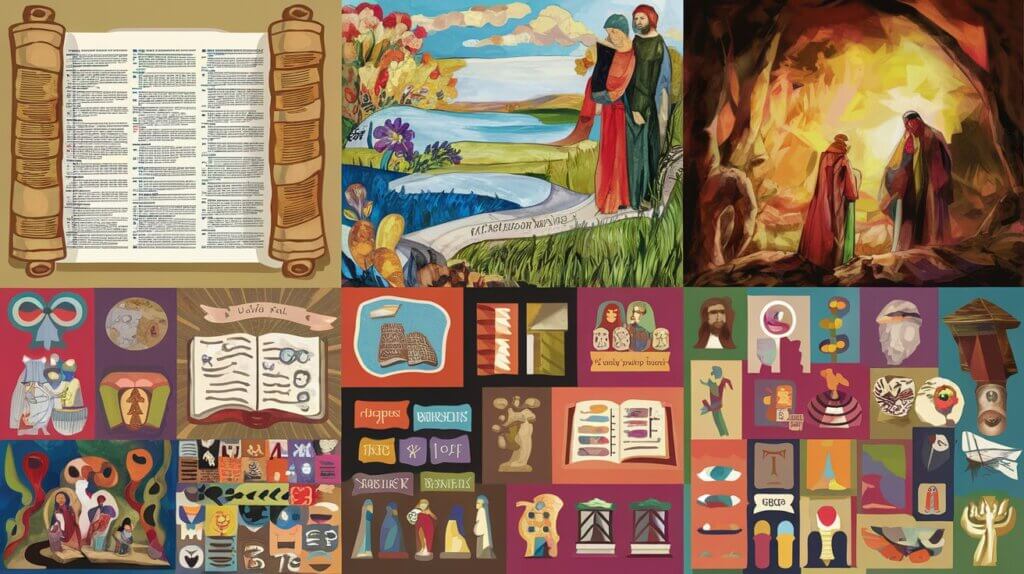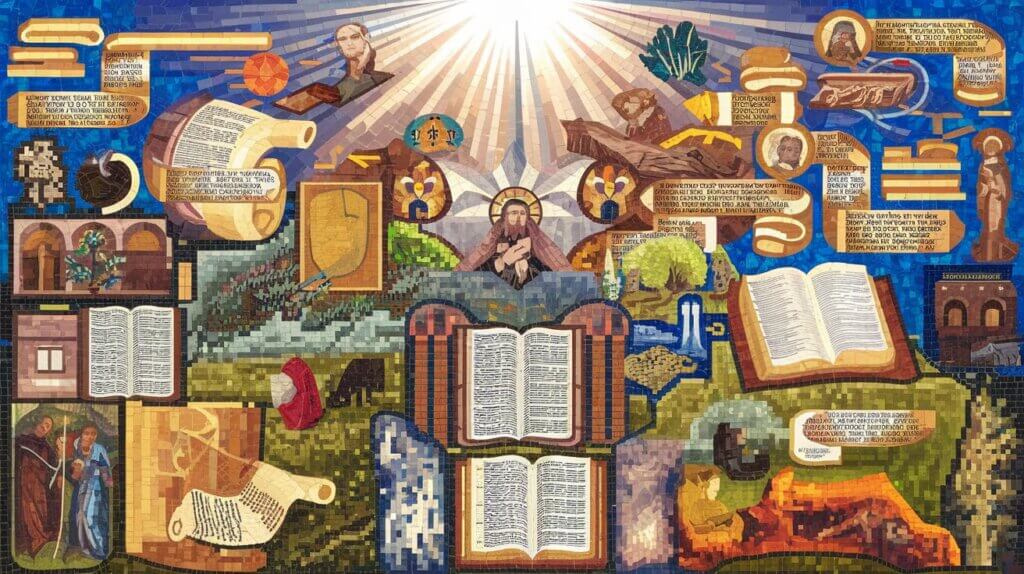This post may contain affiliate links, which means we may receive a commission, at no extra cost to you, if you make a purchase through a link. Please see our full disclosure on the Affiliate Disclosure Page.
Did you know the Bible has over 30 different literary genres? Each one has its own special features and ways to understand it. As a Christian mom, I’ve learned that knowing these genres is key to getting more out of God’s Word. Let’s dive into the colorful world of biblical literature and see how knowing bible genres can change our faith journey.
Key Takeaways
- The Bible has a wide range of literary forms, like stories, poems, prophecies, and letters.
- It’s important to know what makes each biblical literature genre unique for correct understanding and use.
- Looking into the history and culture behind the texts helps us grasp the divine messages better.
- Knowing the different bible genres helps us read the Scriptures with more depth and insight.
- Using specific ways to interpret each genre can strengthen our bond with God’s eternal Word.
Introduction to Biblical Literature and Its Diverse Forms
The Bible is a collection of sacred writings known as the holy scriptures or inspired books. It was written over thousands of years. Understanding its diverse literary forms is key for correct interpretation and application. We will explore the divine nature of Scripture, the importance of recognizing different writing styles, and the historical development of biblical literature.
The Divine Nature of Scripture
Christians believe the Bible is the inspired word of God, written through human authors. This divine origin gives it a unique authority and significance. By acknowledging its sacred nature, we approach it with reverence and an openness to its profound spiritual truths.
Why Understanding Genre Matters in Bible Study
The Bible includes a wide range of literary forms, such as historical narratives, poetic works, prophetic visions, and epistolary writings. Recognizing these genres is crucial for correct interpretation. Each genre has its own conventions, stylistic features, and intended purposes, shaping the meaning and application of the text.
Historical Development of Biblical Writing Styles
The sacred writings of the Bible were composed over centuries. As a result, the literary styles and techniques evolved over time. This evolution reflects the cultural, historical, and linguistic contexts in which they were written. Understanding this historical development offers valuable insights into the diverse forms of biblical literature.
| Literary Genre | Key Characteristics | Examples |
|---|---|---|
| Historical Narrative | Chronological accounts of events, people, and places | The Books of Genesis, Exodus, and 1 & 2 Samuel |
| Poetic and Wisdom Literature | Expressive, figurative language that conveys spiritual insights | The Psalms, Proverbs, and Ecclesiastes |
| Prophetic Literature | Oracles, visions, and messages from God’s appointed spokespeople | The Books of Isaiah, Jeremiah, and Ezekiel |
| Epistles (Letters) | Correspondence written to specific individuals or communities | The Pauline Epistles and the Letters of Peter, James, and John |
Bible Genres and Their Unique Characteristics
The Bible is filled with different kinds of writings, each with its own purpose and style. Knowing about these genres helps us study and understand the Bible better. Let’s look at some of the main genres found in this sacred text.
Historical Narratives
The Bible has many stories about God’s people and His plan. Books like Genesis, Exodus, and Chronicles give us a glimpse into the past. They teach us about human nature, faith, and God’s relationship with us.
Poetry and Wisdom Literature
The poetic and wisdom books, like Psalms, Proverbs, and Ecclesiastes, offer a special view of life. They explore our emotions, the complexities of life, and the search for wisdom.
Prophetic Writings
The prophetic books, including Isaiah, Jeremiah, and Revelation, carry messages from God. They use symbols, images, and visions to share God’s warnings, promises, and the victory of His kingdom.
Epistles and Letters
The New Testament has letters from the apostles to early Christians. These writings tackle practical issues, theological questions, and how to live out faith.
By understanding these different genres, we can appreciate the Bible more. It helps us see the depth and richness of God’s word.

Historical Narrative in Scripture: Stories and Chronicles
The Bible is filled with stories of God’s interactions with His people. These stories give us insights into divine revelation. They help us understand the canonical books of the Scriptures.
Key Features of Biblical Narratives
Biblical stories have some key features:
- They tell events in a straight line.
- They describe historical figures and their actions in detail.
- They show how God guides human history.
- They mix facts with theological interpretations.
Major Historical Books in the Bible
Some important historical books in the Bible are:
- Genesis: Tells of creation, the fall of man, and the early history of the patriarchs.
- Exodus: Describes the Israelites’ journey out of Egypt and the Mosaic covenant.
- 1 and 2 Kings: Covers the reigns of Israel and Judah’s kings.
- 1 and 2 Chronicles: Offers a different view of the same historical events.
Interpreting Historical Accounts
When we study the Bible’s historical stories, we must consider their context. Understanding the audience and purpose helps us see the divine revelation’s relevance today.

| Book | Key Events | Theological Significance |
|---|---|---|
| Genesis | Creation, Fall, Patriarchal History | Shows God as the Creator and the start of the covenant with humanity. |
| Exodus | Exodus from Egypt, Establishment of the Mosaic Covenant | Highlights God’s power to save His people and His desire for a special bond with them. |
| 1 & 2 Kings | Reigns of the Kings of Israel and Judah | Illustrates the results of following or disobeying God’s word. |
Poetic Books and Wisdom Literature
The Bible’s poetic and wisdom books, like Psalms, Proverbs, and Ecclesiastes, give us deep insights into human nature and our bond with God. These rich texts offer a special way to see the human experience and the mysteries of faith.
The poetic books use Hebrew poetry, with techniques like parallelism and figurative language. They invite us to feel deeply and think deeply about our spiritual journey. We connect with the raw emotions in these pages.
The wisdom literature, however, gives us practical advice for daily life. Books like Proverbs and Ecclesiastes talk about morality, ethics, and seeking true wisdom. By studying these texts, we learn how to live a life that pleases God and brings us joy.
Together, the poetic and wisdom books weave a rich tapestry of biblical genres. They help us understand the divine and grow spiritually. As we dive into these literary treasures, we are called to embrace the wonder of God’s Word and apply its wisdom to our lives today.
- Psalms: The inspired songbook of the Bible, expressing a wide range of human emotions and experiences.
- Proverbs: A collection of wise sayings and practical advice for living a righteous life.
- Ecclesiastes: A contemplation on the meaning of life and the pursuit of true fulfillment.
- Song of Songs: A poetic celebration of love and intimacy, often interpreted as an allegory of God’s love for His people.
- Job: A profound exploration of the problem of suffering and the nature of faith.
| Book | Genre | Key Themes |
|---|---|---|
| Psalms | Poetry | Worship, lament, praise, and trust in God |
| Proverbs | Wisdom Literature | Moral instruction, practical advice, and the fear of the Lord |
| Ecclesiastes | Wisdom Literature | The meaning of life, the pursuit of wisdom, and the vanity of human endeavors |
| Song of Songs | Poetry | Love, intimacy, and the celebration of marriage |
| Job | Wisdom Literature | The problem of suffering, the nature of faith, and the sovereignty of God |
Prophetic Literature and Apocalyptic Writings
The Bible has many prophetic and apocalyptic writings, like Isaiah and Revelation. These texts can be hard to understand. Yet, they offer insights into God’s messages of warning, hope, and future events.
Understanding Prophetic Language
Prophetic texts use symbols, metaphors, and vivid images to share divine messages. To grasp these messages, we need to study them carefully. Knowing the historical and cultural background helps us understand their timeless truths.
Symbolism in Apocalyptic Texts
Apocalyptic writings, like Revelation, are full of symbols and vivid descriptions. These symbols might seem confusing at first. But, they hold deep spiritual meanings. Exploring these symbols helps us appreciate the divine messages in these texts.
Time References in Prophetic Literature
- Prophetic texts often mention specific times, like “in the last days.”
- It’s important to understand these time references to interpret the messages correctly.
- Through study and prayer, we can uncover the significance of these time-related elements.
| Prophetic Literature | Apocalyptic Writings |
|---|---|
| Focuses on God’s messages of warning, judgment, and redemption | Emphasizes the ultimate triumph of God and the establishment of His eternal kingdom |
| Utilizes symbolic language and vivid imagery to convey divine truths | Employs complex symbolism and visionary descriptions of future events |
| Provides insights into the present and future, often with specific time references | Offers a glimpse into the cosmic battle between good and evil, and the final victory of God |

Exploring prophetic and apocalyptic writings helps us understand the Bible better. This knowledge lets us grasp God’s messages of warning, hope, and His ultimate victory.
Letters and Epistles in the New Testament
The New Testament is more than just inspired books. It’s also filled with letters and epistles from the apostles. These writings give us a peek into the early Christian church. They also offer practical advice for living a life based on the holy scriptures.
The apostle Paul’s letters are a highlight of the New Testament. He wrote to various churches and individuals, covering many topics. His letters help us understand the early Christian community’s growth and challenges.
Other important epistles come from Peter, James, John, and Jude. Each apostle shared their unique views and addressed specific issues. These letters show us the triumphs and struggles of the first followers of Christ.
| Epistle | Author | Primary Focus |
|---|---|---|
| Romans | Paul | Theology of salvation and Christian living |
| 1 Corinthians | Paul | Addressing issues in the Corinthian church |
| 1 Peter | Peter | Encouraging persecuted Christians |
| 1 John | John | Distinguishing true faith from false teachings |
Studying these letters and epistles deepens our understanding of the holy scriptures. They are the core of our Christian faith. By following the timeless wisdom in these epistles, we can strengthen our bond with God. We can also live out the New Testament’s teachings every day.

Gospel Narratives: A Unique Biblical Genre
The four Gospels – Matthew, Mark, Luke, and John – are a special part of religious texts. They mix history with deep theological meaning. This gives us a full picture of Jesus Christ’s life, teachings, and work.
Synoptic Gospels vs. John’s Gospel
The first three Gospels, or Synoptic Gospels, share a similar view and structure. John’s Gospel, however, takes a unique and more focused theological approach. The Synoptic Gospels give a unified view of Jesus’ ministry. John’s Gospel explores Christ’s divine nature and his bond with the Heavenly Father.
Literary Devices in Gospel Writing
- Parables: The Gospel writers often use parables to share Jesus’ teachings and principles.
- Symbolism: Symbolic language and imagery add depth and meaning to the Gospel stories.
- Eyewitness Accounts: The Gospels include firsthand accounts from those who saw Jesus’ life and work.
Cultural Context of Gospel Literature
To truly understand the Gospels, we must grasp their cultural and historical setting. The Gospels show the customs, traditions, and beliefs of ancient Near Eastern and Greco-Roman societies. They give us a glimpse into Jesus’ and his followers’ lives.
| Synoptic Gospels | John’s Gospel |
|---|---|
| Emphasize Jesus’ earthly ministry and miracles | Focuses on Jesus’ divine nature and relationship with the Father |
| Provide a harmonized perspective of Jesus’ life | Offers a unique and more theologically-focused approach |
| Utilize more parables and less symbolic language | Incorporates more symbolic language and imagery |
Law and Legal Texts in Scripture
The Bible is more than just canonical books with stories and teachings. It also has a lot of law and legal texts, especially in Leviticus and Deuteronomy. These laws give us a peek into the ancient Israelites’ culture and history.
It’s important to understand the purpose and structure of these laws. They outline the rules for the Israelites’ daily lives. Topics include worship, social interactions, and moral conduct.
Exploring the Purpose of Biblical Law
The laws in the Bible have several key roles:
- They show God’s desire for his people to live righteously, mirroring his holiness.
- They help create a stable society, promoting harmony and community well-being.
- They give us a glimpse into the Israelites’ world, helping us understand the stories.
- They hint at God’s ultimate plan through Jesus Christ’s life, death, and resurrection.
Navigating the Complexity of Biblical Law
The laws in the Bible can be tricky to understand. They often talk about cultural practices and norms that seem strange today. But, by studying them carefully and humbly, we can learn about God’s heart for his people. We can also discover principles to guide our lives as followers of Christ.
| Key Features of Biblical Law | Examples from the Text |
|---|---|
| Moral and ethical guidelines | The Ten Commandments (Exodus 20:1-17) |
| Ceremonial and ritual regulations | Laws regarding sacrifice and worship (Leviticus 1-7) |
| Civil and social statutes | Laws concerning property rights and justice (Deuteronomy 19-25) |
By diving into the canonical books and divine revelation in the Bible’s legal texts, we can appreciate God’s complete plan for his people. We also learn timeless principles to guide us in our lives.
Conclusion
As we finish our look at the Bible’s many genres, we see its deep richness. Understanding each genre, from stories to poems, helps us get more from God’s Word. This knowledge helps us live out our faith as Christian mothers and believers.
Exploring the Bible’s genres, from Old Testament prophecies to New Testament letters, is key. It lets us grasp the full meaning of the text. This understanding helps us grow in faith and share God’s message with others.
As we end our journey through the Bible’s genres, let’s keep exploring God’s Word. Let’s use what we’ve learned to find wisdom and guidance every day. May we approach the Scriptures with reverence, humility, and a deep longing to understand our Heavenly Father’s heart.

